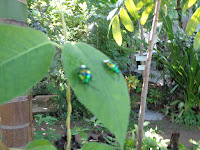Living with Nature Center Series 2
Arboretum and Garden
San Vicente, Ilocos Sur
An arboretum is an outdoor living tree museum. A garden is a planned plot of land adjoining a house for cultivating plants, flowers and fruits, and other forms of nature.
Dr Abe V Rotor
Arboretum or Miniature Tropical Rainforest
As miniature replica, the Center maintains the three-storey distinct
structure of a tropical rainforest, namely, underbrushes, canopy layer,
and emergents, cum epiphytes and lianas, as virtual field laboratory
in forestry and ecology, and other related fields of study.
Dead Forest
Where once stood a lush vegetation of trees, shrubs, liana and orchid -
these are but remnants, reminiscent of Paradise John Milton's poetry,
except for one thing - we may never see it regained in our life time.
Indigenous Food Plants
Top clockwise, karamay (Cicca acida), kamias (Averrhoa balimbi),
ngalog (Portulaca oleracea), batao (Dolichos lablab), pallang Ilk
(Psophocarpus tetragonolobus), patani (Phaseolus lunatus). Wild
food plants are crucial in providing food and nutrition in times of
food shortage and hunger.

Herbal Medicine
Luyang dilaw (Curcuma longa) or turmeric is an effective remedy for
osteoarthritis, hay fever, depression, and high cholesterol. The rhizome
is a good source of phosphorus and iron. Oregano (Origanum vulgare)
contains antioxidants, and offers many health benefits. Lowermost
photos, Aloe vera for restoring hair, and Jatropha multifida made into
topical ointment.
Ethnobotany
Considered as weeds certain edible plants, such as alugbati and
karimbuaya or soro-soro, offer an alternative to conventional
vegetables and fruits. This field of study is valuable in preserving
biodiversity and in solving problems of food shortage and
malnutrition.
Pest Buildup
Top, cabbage aphids (Brevicoryne brassicae) gain resistance
against repeated chemical spraying. Middle, Cotton Stainer
(Dysdercus cingulatus = D. megalophygus), coconut beetle
(Oryctes rhinocerus), green beetle, kamote weevil (Cylas
formicarius) are gaining the upper hand in our war against pest
using chemicals. Their tool: immunity. Immunity enables them
to survive the onslaught of pesticides which killed their forebears.
Such resistance increases and passed on to their offspring onward.
Living things evolve, and in the transition period may show
incipient signs of change veering away from their own kind.
The process may lead to the formation of variants, which may
become distinctly new species.
Microcosm of a river, lake, or a large scale fishery right on the
backyard as source of food, recreation, or simply a place for
creativity and respite.

































No comments:
Post a Comment